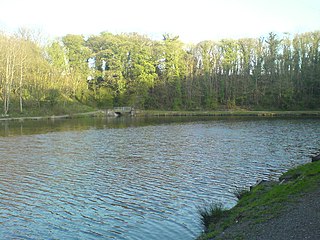Related Research Articles

The Ellesmere Canal was a waterway in England and Wales that was planned to carry boat traffic between the rivers Mersey and Severn. The proposal would create a link between the Port of Liverpool and the mineral industries in north east Wales and the manufacturing centres in the West Midlands. However, the canal was never completed as intended because of its rising costs and failure to generate the expected commercial traffic.

The Buckley Railway was opened from Buckley to a connection with the Chester to Holyhead main line on 7 June 1862, to convey coal and finished brickworks products from the Buckley area. Numerous short tramroads had existed in the area from the 1700s. The line was steeply graded and sharply curved.
The Wrexham and Minera Railway or Wrexham and Minera Branch was a railway line in North Wales between the city of Wrexham, the village of Brymbo where it served the Brymbo Steelworks, and the lead mines and limeworks at Minera. A further branch ran from Brymbo to Coed Talon, where it connected with lines to Mold. The system was constructed in several stages between 1844 and 1872, while the various lines making up the system closed in 1952, 1972 and 1982.

The Brymbo Steel Works was a former large steelworks in the village of Brymbo near Wrexham, Wales. In operation between 1796 and 1990, it was significant on account of its founder, one of whose original blast furnace stacks remains on the site.

Croes Newydd was a large steam locomotive shed, marshalling yard and junction in Wrexham, in Wales.

Gwersyllt railway station serves the area of Gwersyllt in the city of Wrexham in North Wales. It is one of five stations in the Wrexham County Borough.
The North Wales Mineral Railway was constructed in Wales in 1844, during the early years of the Railway Mania. It was originally intended to link Chester via Wrexham to the industrial areas around Ruabon; there were branches to Brymbo and Minera from Wheatsheaf junction via a tunnel and inclined plane. The initial plan was to tap the mineral reserves of the area.

The Moss Valley is an area and country park in Wrexham County Borough, Wales. The area, informally known as "The Moss" and The Aggey by local people, has an extensive coal mining history.
Summerhill is a semi-urban village in the suburbs of Wrexham, Wales and forms part of the community of Gwersyllt.

Gwersyllt is an urban village and community in Wrexham County Borough, Wales.

Coed Talon is a small, formerly industrial village between Leeswood and Treuddyn in Flintshire, Wales. Its name is derived from the Welsh word coed ("wood") and the word talwrn, anglicised to "Talon", meaning a "hillside devoid of trees" or "threshing-floor". Other translations of "Talwrn" suggest the words "lumber", "spot" or "field".

Stansty is an area and electoral ward in Wrexham County Borough, Wales, lying to the immediate north-west of the city of Wrexham. It is a former civil parish and township. Stansty is also an electoral ward to Wrexham County Borough Council. The ward population as taken at the 2011 Census was 2,114.

Henry Robertson was a Scottish mining engineer and prolific railway builder, industrialist and Liberal Party politician. He was head of Brymbo Steelworks, Wrexham. He was co-founder of Beyer-Peacock, with Charles Beyer, and Richard Peacock. His son Sir Henry Beyer Robertson was knighted by Queen Victoria for the achievements of his father.

The North Wales Mineral Railway was formed to carry coal and ironstone from the mineral-bearing area around Wrexham to the River Dee wharves. It was extended to run from Shrewsbury and formed part of a main line trunk route, under the title The Shrewsbury and Chester Railway. It opened in 1846 from Chester to Ruabon, and in 1848 from Ruabon to Shrewsbury. It later merged with the Great Western Railway.
The Mold Railway was a railway company that built a line in north-east Wales. The line linked Mold to Chester and it opened on 14 August 1849. The company built a mineral branch line to Ffrith, opened in November 1849. Mold itself was an important regional centre, and contained considerable mineral resources.

Tanyfron is a village in Wrexham County Borough in Wales. At the time of the 2001 census, the population of area Wrexham 006A, which includes Tanyfron and a number of other small settlements, was 1,347. The village is part of the local government Community of Brymbo and is in the Vron electoral ward. The built-up area had a population of well over 2,000 as of the 2011 census.

The Ruabon Brook Tramway was a Welsh horse-drawn tramway linking the Ruabon coalfield to the Ellesmere Canal at Froncysyllte, with a private extension into the Monsanto works at Cefn Mawr which reconnected to the main line at Trevor. The area was rich in coal, clay and minerals.
Moss Valley branch was a two mile long single track line built by the Great Western Railway in what is now the county borough of Wrexham, Wales. It ran from a junction with the Wrexham and Minera Railway at Moss Valley Junction to Moss Halt via three intermediate stations: Gatewen Halt, Pentre Broughton Halt, and Gwersyllt Hill Halt.

The Brymbo railway branch lines served the rich reserves of coal, iron, limestone and other minerals in an area around Brymbo to the west of Wrexham in Wales. Coalowners and others needed transport to get their products to market and lines were built from the main line into the mineral-bearing area. The topography was difficult and gradients were steep. The Great Western Railway became dominant, but a rival company built a competing line and branches.
References
- ↑ Forgotten Relics - Summerhill and Brymbo Tunnels
- ↑ "Gwersyllt Colliery". www.welshcoalmines.co.uk. Retrieved 11 July 2013.